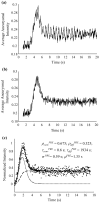Treatment of rabbit elastase-induced aneurysm models by flow diverters: development of quantifiable indexes of device performance using digital subtraction angiography
- PMID: 19164085
- PMCID: PMC2702458
- DOI: 10.1109/TMI.2008.2012162
Treatment of rabbit elastase-induced aneurysm models by flow diverters: development of quantifiable indexes of device performance using digital subtraction angiography
Abstract
It has been known for more than a decade that intracranial aneurysms can be successfully treated by deploying a porous meshed tube in the parent vessel of the aneurysm. Such devices are currently called flow diverters because they promote intraneurysmal flow stasis and thrombosis by diverting blood flow away from the aneurysm sac. The objective of this study was to use angiographic data to quantify and compare the performance of flow diverters of original design in successfully occluding an experimental aneurysm model. Three different configurations of a novel flow diverter with varying porosities and pore densities were implanted in 30 rabbit elastase-induced aneurysms. Temporal variations in angiographic contrast intensity within the aneurysms were fit to a mathematical model. Optimized model parameters were supplemented by the angiographic percentage aneurysm occlusion and an angiographic measure of device flexibility to derive composite scores of performance. Angiographic quantification further suggested a parameter, which could be employed to estimate long-term aneurysm occlusion probabilities immediately after treatment. Performance scores showed that the device with a porosity of 70% and pore density of 18 pores/mm (2) performed better than devices with 65% porosity, 14 pores/mm (2), and 70% porosity, 12 pores/mm (2) with relative efficacies of 100%, 84%, and 76%, respectively. The pore density of flow diverters, rather than porosity, may thus be a critical factor modulating device efficacy. A value of the prognostic parameter of less than 30 predicted greater than 97% angiographic aneurysm occlusion over six months with a sensitivity of 73% and specificity of 82%.
Figures








Similar articles
-
An original flow diversion device for the treatment of intracranial aneurysms: evaluation in the rabbit elastase-induced model.Stroke. 2009 Mar;40(3):952-8. doi: 10.1161/STROKEAHA.108.533760. Epub 2009 Jan 15. Stroke. 2009. PMID: 19150864 Free PMC article.
-
In vitro digital subtraction angiographic evaluation of flow diverters in a patient-specific aneurysm.Interv Neuroradiol. 2017 Jun;23(3):260-266. doi: 10.1177/1591019917694023. Epub 2017 Jan 1. Interv Neuroradiol. 2017. PMID: 28604187 Free PMC article.
-
Hemodynamics of Flow Diverters.J Biomech Eng. 2017 Feb 1;139(2). doi: 10.1115/1.4034932. J Biomech Eng. 2017. PMID: 27727400
-
Correlation between angiographic and particle image velocimetry quantifications of flow diverters in an in vitro model of elastase-induced rabbit aneurysms.J Biomech Eng. 2009 Mar;131(3):034506. doi: 10.1115/1.3049528. J Biomech Eng. 2009. PMID: 19154077 Free PMC article.
-
Measurement of quantifiable parameters by time-density curves in the elastase-induced aneurysm model: first results in the comparison of a flow diverter and a conventional aneurysm stent.Eur Radiol. 2013 Feb;23(2):521-7. doi: 10.1007/s00330-012-2611-2. Epub 2012 Aug 16. Eur Radiol. 2013. PMID: 22895618
Cited by
-
Endoluminal scaffolds for vascular reconstruction and exclusion of aneurysms from the cerebral circulation.Stroke. 2010 Oct;41(10 Suppl):S21-5. doi: 10.1161/STROKEAHA.110.595066. Stroke. 2010. PMID: 20876497 Free PMC article. Review.
-
Evaluation of a second-generation self-expanding variable-porosity flow diverter in a rabbit elastase aneurysm model.AJNR Am J Neuroradiol. 2011 Sep;32(8):1399-407. doi: 10.3174/ajnr.A2548. Epub 2011 Jul 14. AJNR Am J Neuroradiol. 2011. PMID: 21757527 Free PMC article.
-
Parent Artery Reconstruction for Large or Giant Cerebral Aneurysms Using the Tubridge Flow Diverter: A Multicenter, Randomized, Controlled Clinical Trial (PARAT).AJNR Am J Neuroradiol. 2018 May;39(5):807-816. doi: 10.3174/ajnr.A5619. Epub 2018 Mar 29. AJNR Am J Neuroradiol. 2018. PMID: 29599173 Free PMC article. Clinical Trial.
-
Tubridge flow-diverting stent for treatment of unruptured intracranial complex aneurysms.Front Neurol. 2025 Jun 16;16:1584983. doi: 10.3389/fneur.2025.1584983. eCollection 2025. Front Neurol. 2025. PMID: 40589988 Free PMC article.
-
Relationship between aneurysm occlusion and flow diverting device oversizing in a rabbit model.J Neurointerv Surg. 2016 Jan;8(1):94-8. doi: 10.1136/neurintsurg-2014-011487. Epub 2014 Nov 11. J Neurointerv Surg. 2016. PMID: 25387731 Free PMC article.
References
-
- Turjman F, Acevedo G, Moll T, Duquesnel J, Eloy R, Sindou M. Treatment of experimental carotid aneurysms by endoprosthesis implantation: preliminary report. Neurol. Res. 1993;15:181–184. - PubMed
-
- Lieber BB, Stancampiano AP, Wakhloo AK. Alteration of hemodynamics in aneurysm models by stenting: influence of stent porosity. Ann. Biomed. Eng. 1997 May-Jun;25(no. 3):460–469. - PubMed
Publication types
MeSH terms
Substances
Grants and funding
LinkOut - more resources
Full Text Sources
Medical

